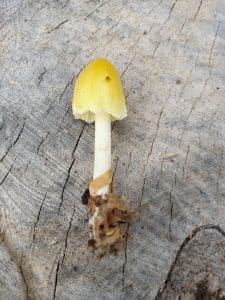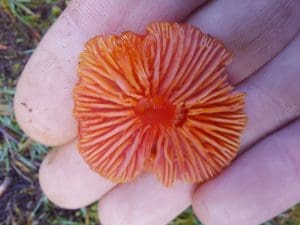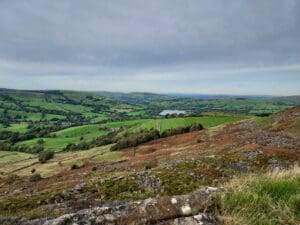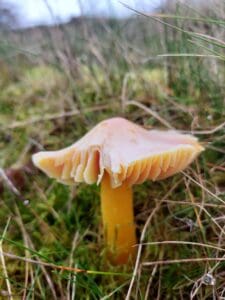Waxcaps are familiar-shaped fungi that are often brightly-coloured with a waxy or slippery-looking cap we’re going to take a closer look at them in this introduction to waxcap mushrooms piece. The botanical name for this family is Hygrocybe meaning ‘watery head’. They are typically found in grasslands that are poor in nutrients, places such as old pasture, sand dunes, heathland, lawns and cemeteries. They do sometimes also appear in woodlands.
The grasslands of the UK are some of the best places in the world to find them but due to changes in land use and the increased use of artificial fertilisers they are getting harder and harder to find. We’ve lost about 90% of suitable grasslands in the UK over the past century. Some are now so rare that they are protected by law and it would be an offence to harvest them.
From an edibility point of view most are edible but due to their scarcity and their slimy nature there’s only really a few that I consider to be good for the kitchen such as the Meadow Waxcap (Hygrocybe Pratensis), and only then if i find them in abundance.
Listen to our Introduction to Waxcap Mushroom Podcast
This is an ai generated podcast from our database, we’re sharing it because our team have genuinely found it useful
How to identify Waxcap Mushroom;
They tend to be quite easy to identify as a group, the key features to look for are:
- Smooth to slightly scaly caps that are convex to conical and waxy or sticky when damp.
- Many are brightly coloured in shades of red, orange, or yellow.
- Where present, the gills beneath the cap are equally coloured and usually distant, thick, and waxy.
- The stems of Hygrocybe species lack a ring.
- The spore print is white.
- Fruit bodies of some species, for example the Blackening Waxcap (Hygrocybe conica), blacken with age or when bruised.
There are around 150 different waxcap species in the UK, here are some of the more common ones;
Crimson waxcap mushroom
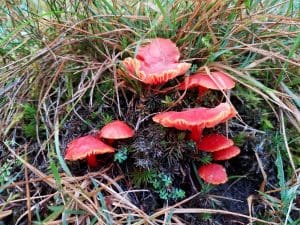
The Crimson Waxcap (Hygrocybe punicea) is one of the most striking and beautiful fungi you’ll encounter in the UK’s grasslands and meadows. With its vivid crimson-red cap, tall yellowish stem, and waxy texture, this mushroom is a true showstopper during the autumn months. It thrives in unimproved, nutrient-poor grasslands, making it an important indicator of ancient, undisturbed habitats.
Find out more on the Crimson Waxcap here
Meadow waxcap mushroom
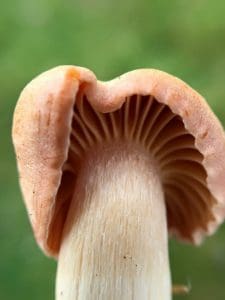
The Meadow Waxcap (Cuphophyllus pratensis), also known as the Meadow Cap, is a charming mushroom that graces the UK’s grasslands in autumn. With its pale orange to apricot-coloured cap, thick waxy gills, and stout white stem, this species may not be as flamboyant as some of its waxcap relatives, but its understated beauty is unmistakable. Found in unimproved meadows and nutrient-poor lawns, the Meadow Waxcap is a sign of healthy, ancient grassland ecosystems.
Find out more on the Meadow Waxcap here
Snowy waxcap mushroom
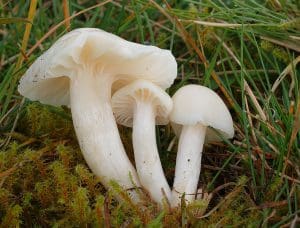
The Snowy Waxcap (Cuphophyllus virgineus), also known as the Snowy White Waxcap, is a pristine and elegant mushroom that brightens up grasslands and meadows in the autumn months. Its smooth, pure white cap, waxy gills, and slender stem make it a striking and easily recognisable species. This beautiful fungus thrives in unimproved, nutrient-poor grasslands, often appearing in clusters that resemble scattered pearls on the landscape.
Find out more on the Snowy Waxcap here
You can Help protect their habitats
As I mentioned earlier, unfertilised grasslands are getting rarer and rarer which is bad not only for mushroom hunters but also the planet as a whole. Undisturbed grasslands store a third of the world’s land-based carbon in their soils. The charity Plantlife has an app that you can use to record Waxcap sightings. Sending in sightings of waxcaps can help experts identify forgotten patches of old grassland, which they can then target for protection.
Check out more info on a waxcap survey



